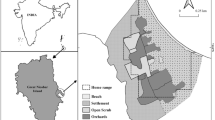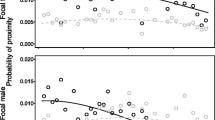Abstract
We observed the grooming interactions of 13 female rhesus monkeys (Macaca mulatta)before and for 12 weeks after the births of their infants. Mothers groomed for similar amounts of time before and after the birth of their infants, but after the birth, the grooming they directed to their infants may have been at the expense of that directed to other partners. Lactating females did not receive more grooming from other females but were approached more often, suggesting that they were more attractive. Mothers that groomed their infants most groomed others least, as if grooming time was limited for each mother or as if she was trying to compensate for avoiding interactions with other partners. Mothers of male infants groomed others more than mothers with female infants did, which might be due to mothers with daughters receiving more aggression and therefore avoiding interaction. Experienced and high-ranking mothers groomed their newborn infants considerably more than primiparous mothers did in the 24 hr following birth. Grooming was preferentially directed at close kin before the births of the infants. Mothers tended to groom higher-ranked partners more than they were groomed by them, and they tended to receive more grooming from lower-ranked partners than they gave, as suggested in models of rank attractiveness.
Similar content being viewed by others
References
Altmann, J. (1974). Observational study of behavior: Sampling methods.Behaviour 49: 227–265.
Barton, R. (1985). Grooming site preferences in primates and their functional implications.Int. I. Primatol. 6: 519–532.
Berman, C. M. (1980). Mother-infant relationships among free-ranging rhesus monkeys on Cayo Santiago: A comparison with captive pairs.Anim. Behav. 28: 860–873.
Bernstein, I. S., and Sharp, L. G. (1966). Social roles in a rhesus monkey group.Behaviour 26: 91–104.
Boccia, M. L. (1989). Comparison of the physical characteristics of grooming in two species of macaque(Macaca nemestrina andMacaca radiata).J. Comp. Psychol. 103: 177–183.
Boccia, M. L., Reite, M., and Laudenslager, M. (1989). On the physiology of grooming in a pigtail macaque.Physiol. Behav. 45: 667–670.
de Waal, F. B. M., and Luttrell, L. M. (1986). The similarity principle underlying social bonding among female rhesus monkeys.Folia Primatol 46: 215–234.
de Waal, F. B. M., and Luttrell, L. M. (1989). Towards a comparative socioecology of the genus Macaca: Different dominance styles in rhesus and stumptail monkeys.Am J. Primatol. 19: 83–109.
Dunbar, R. I. M. (1988).Primate Social Systems, Croom Helm, London.
Dunbar, R. I. M. (1991). Functional significance of social grooming in primates.Folia Primatol. 57: 121–131.
Falk, J. L. (1958). The grooming behavior of the chimpanzee as a reinforcer.J. Exp. Anal. Behav. 1: 83–85.
Hinde, R. A., and Proctor, L. P. (1977). Changes in the relationships of captive rhesus monkeys on giving birth.Behaviour 61: 304–321.
Hinde, R. A., and Stevenson-Hinde, J. (1976). Towards understanding relationships: Dynamic stability. In Bateson, P. P. G., and Hinde, R. A. (eds.),Growing Points in Ethology, Cambridge University Press, Cambridge, pp. 451–479.
Hooley, J. M. (1983). Primiparous and multiparous mothers and their infants. In Hinde, R. A. (ed.),Primate Social Relationships, Blackwell Scientific, London, pp. 142–145.
Johnson, R. L., and Southwick, L. H. (1984). Structural diversity and mother-infant relations among rhesus monkeys in Nepal and India.Folia Primatol. 43: 189–248.
Keverne, E. B. (1988). Central mechanisms underlying the neural and neuroendocrine determinants of maternal behavior.Psychoneuroendocnnology 13: 127–141.
Keverne, E. B., Martensz, N. D., and Tuite, B. (1989). Beta-endorphin concentrations in cerebrospinal fluid of monkeys are influenced by grooming relationships.Psychoneuroendocnnology 14: 155–161.
Kummer, H. (1978). On the value of social relationships to nonhuman primates.Soc. Sci. Inform. 17: 687–705.
Loy, J. (1970). Behavioral responses of free-ranging rhesus monkeys to food shortage.Am. J. Phys. Anthropol. 33: 263–272.
Maestripieri, D. (1993). Vigilance costs of allogrooming in macaque mothers.Am. Nat. 141: 744–753.
Panksepp, J., Herman, B. H., Vilberg, T., Bishop, P., and de Eskinazi, F. G. (1980). Endogenous opioids and social behaviour.Neurosci. Biobehav. 4: 437–487.
Rowell, T. E., Hinde, R. A., and Spencer-Booth, Y. (1964). Aunt-infant interaction in captive rhesus monkeys.Anim. Behav. 12: 219–226.
Rowell, T. E. Wilson, C., and Cords, M. (1991). Reciprocity and partner preference in grooming of female blue monkeys.Int. J. Primatol. 12: 319–336.
Sade, D. (1965). Some aspects of parent-offspring and sibling relations in a group of rhesus monkeys, with a discussion of grooming.Am. J. Phys. Anthropol 23: 1–18.
Seyfarth, R. M. (1976). Social relationships among adult female baboons.Anim. Behav. 24: 917–938.
Seyfarth, R. M. (1980). The distribution of grooming and related behaviors among adult female vervet monkeys.Anim. Behav. 28: 798–813.
Seyfarth, R. M. (1983). Grooming and social competition in primates. In Hinde, R. A. (ed.),Primate Social Relationships, Blackwell Scientific, London, pp. 182–190.
Silk, J. B. (1982). Altruism among femaleMacaca radiata: Explanations and analysis of patterns of grooming and coalition formation.Behavior 79: 162–188.
Silk, J. B., Samuels, A., and Rodman, P. S. (1981). The influence of kinship, rank and sex on affiliation and aggression between adult female and immature bonnet macaques(Macaca radiata).Behaviour 78: 111–137.
Simpson, M. J. A. (1991). On declaring commitment to a partner. In Bateson, P. P. G. (ed.),The Development and Interpretation of Behaviour. Essays in Honour of Robert Hinde, Cambridge University Press, Cambridge, pp. 271–293.
Simpson, M. J. A. and Simpson, A. E. (1982). Birth sex ratios and social rank in rhesus monkey mothers.Nature 300: 440–441.
Simpson, A. E., and Simpson, M. J. A. (1985). Short-term consequences of different breeding histories for captive rhesus macque mothers and young.Behav. Ecol. Sociobiol. 18: 83–89.
Simpson, M. J. A., Simpson, A. E., and Howe, S. (1986). Changes in the rhesus mother-infant relationship through the first four months of life.Anim. Behav. 34: 1528–1539.
Simpson, M. J. A., Gore, M. A. Janus, M., and Rayment, F. D. G. (1989). Prior experience of risk and individual differences in enterprise shown by rhesus monkey infants in the second half of their first year.Primates 30: 493–509.
Stammbach, E. (1988). Group responses to specially skilled individuals in aMacaca fascicularis group.Behaviour 107–266.
Teas, J., Richie, T., Taylor, H., and Southwick, C. (1980). Population patterns and behavioral ecology of rhesus macaques(Macaca mulatto) in Nepal. In Lindburg, D. G. (ed.),The Macaques, van Nostrand Reinhold, New York, pp. 247–262.
Trivers, R. (1985).Social Evolution, BenjaminJCummings, Menlo Park CA.
Author information
Authors and Affiliations
Rights and permissions
About this article
Cite this article
Martel, F.L., Nevison, C.M., Rayment, F.D.G. et al. The social grooming of captive female rhesus monkeys: Effects of the births of their infants. Int J Primatol 15, 555–572 (1994). https://doi.org/10.1007/BF02735971
Received:
Revised:
Accepted:
Issue Date:
DOI: https://doi.org/10.1007/BF02735971




